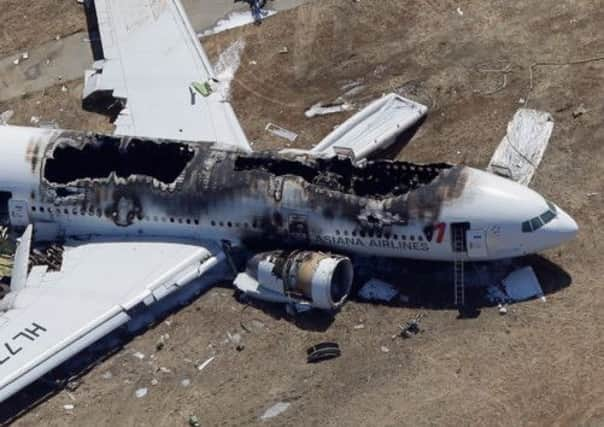San Francisco crash: Of 307 onboard, only two die


Police officers threw knives up to crew members inside the burning wreckage of Asiana Airlines Flight 214 so they could cut away passengers’ seat belts.
Passengers jumped down emergency slides, escaping from thick billowing smoke.
Advertisement
Hide AdAdvertisement
Hide AdAmid the chaos, some urged fellow passengers to keep calm, even as flames tore through the Boeing 777’s fuselage.
As investigators try to determine what caused the crash of Flight 214, which killed two Chinese teenage girls on Saturday, the accident left many wondering how nearly all 307 people aboard were able to make it out alive.
The airline said there were 16 crew members aboard and 291 passengers. Thirty of the passengers were children.
Chinese state media identified the dead as two 16-year-old girls from China’s eastern Zhejiang province.
San Francisco Fire Department chief Joanne Hayes-White said the two who died were found outside of the plane. “Having surveyed that area, we’re lucky that there hasn’t been a greater loss,” she said.
Airport spokesman Doug Yakel said 49 people were critically injured and 132 had less significant injuries.
“It’s miraculous we survived,” said passenger Vedpal Singh, who had a fractured collarbone and whose arm was in a sling.
Investigators took the flight data recorder to Washington, DC, to begin examining its contents for clues to the last moments of the flight, officials said. They also plan to interview the pilots, the crew and passengers.
Advertisement
Hide AdAdvertisement
Hide Ad“I think we’re very thankful that the numbers were not worse when it came to fatalities and injuries,” said National Transportation Safety Board chief Deborah Hersman. “It could have been much worse.”
Ms Hersman said investigators are looking into what role the shutdown of a key navigational aid may have played in the crash. She said the glide slope – a ground-based aid that helps pilots stay on course while landing – had been shut down since June.
Since the plane was about to land, its landing gear would have already been down, said Mike Barr, a former military pilot and accident investigator.
It is possible the landing gear or the tail of the plane hit the seawall, he said. If that happened, it would effectively slam the plane into the runway.
“When you heard that explosion, that loud boom and you saw the black smoke… you just thought, my god, everybody in there is gone,” said Ki Siadatan, who lives a few miles from the airport and watched the plane’s “out of control” approach from his balcony.
“My initial reaction was ‘I don’t see how anyone could have made it’,” he said.
Inside the plane, Mr Singh, who was sitting in the middle of the aircraft with his family, said there was no forewarning from the pilot or any crew members before the plane touched down hard and he heard a loud sound.
“We knew something was horrible wrong,” said a visibly shaken Mr Singh. He said the plane went silent before people tried to get out anyway they could.